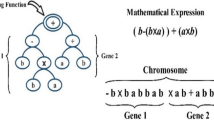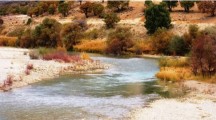Conclusions
-
1.
It is necessary to correlate the value of the noneroding velocity with the time of flood passage. If canals are planned in regions where comparatively brief summer floods are dominant, the value of the noneroding velocity should be taken equal to 3 m/sec since by the start of the flood the grass cover will have time to develop and reach maximum strength. If the canals are to be constructed in regions where spring floods are dominant, for example, in the northwestern regions of the country, then the noneroding velocity should be taken equal to 1.5 m/sec, since by the start of the flood the grass carpet does not have time to develop and become stronger.
-
2.
In the absence of a constant runoff in the canal, for example, drainage canals, it is necessary to revet the bottom and side slopes with grass carpets.
-
3.
In the presence of a constant moistening is made from traditional materials, in the zone of alternate moistening and above it, it is necessary to revet the slopes within reinforced grass carpet.
-
4.
In a hydraulic calculation of canals with revetment of the bottom and side slopes with grass carpet, it is necessary to determine the roughness coefficient from the graph of n=f(VR, i). In a hydraulic calculation of wide overgrown channels and in calculation of the movement of the flow over floodplain stretches of rivers free from shrubs and trees, it is necessary to determine the roughness coefficient from the graph of n=f(Vh, i).
-
5.
Calculation of canals with nonuniform roughness (rigid revetment and revetment by grass carpets) must be carried out on the basis of relations of uniform flow by means of a generalized roughness coefficient.
A method of hydraulic calculation of canals with revetment by grass carpets with presentation of an algorithm and calculation examples was developed from the results of the studies.
Similar content being viewed by others
Literature cited
V. I. Borovitskii, P. V. Grinshpun, N. N. Zarazha, V. A. Pozdin, and M. N. Sobolevskii, “Grass carpets for revetting drainage canals,” Gidrotekh. Melior., No. 10 (1970).
A. F. Dmitriev, “Hydraulic resistance coefficient of vegetated channels,” in: Hydraulic and Hydraulic Engineering, Republic Interdepartmental Scientific-Technical Collection [in Russian], No. 18 (1974).
A. F. Dmitriev, V. A. Korneev, V. A. Pozdin, and P. V. Grinshpun, “Maximum water velocities in canals covered with a protective grass carpet,” Éksp. Inf., Ser. 2, No. 31, Moscow (1972).
M. Sepp and A. Maastik, “Hydraulic studies of grassed slopes,” in: Collection of Works of the Estonian Agricultural Academy [in Russian], Tartu, No. 31 (1963).
V. T. Chow, Open-Channel Hydraulics, McGraw-Hill, New York (1959).
Additional information
Translated from Gidrotekhnicheskoe Stroitel'stvo, No.5, pp. 30–33, May, 1992.
Rights and permissions
About this article
Cite this article
Dmitriev, A.F., Tyshenko, A.I. & Khlapuk, N.N. Hydraulic studies of grass carpets for revetting canals. Hydrotechnical Construction 26, 306–310 (1992). https://doi.org/10.1007/BF01545044
Issue Date:
DOI: https://doi.org/10.1007/BF01545044




